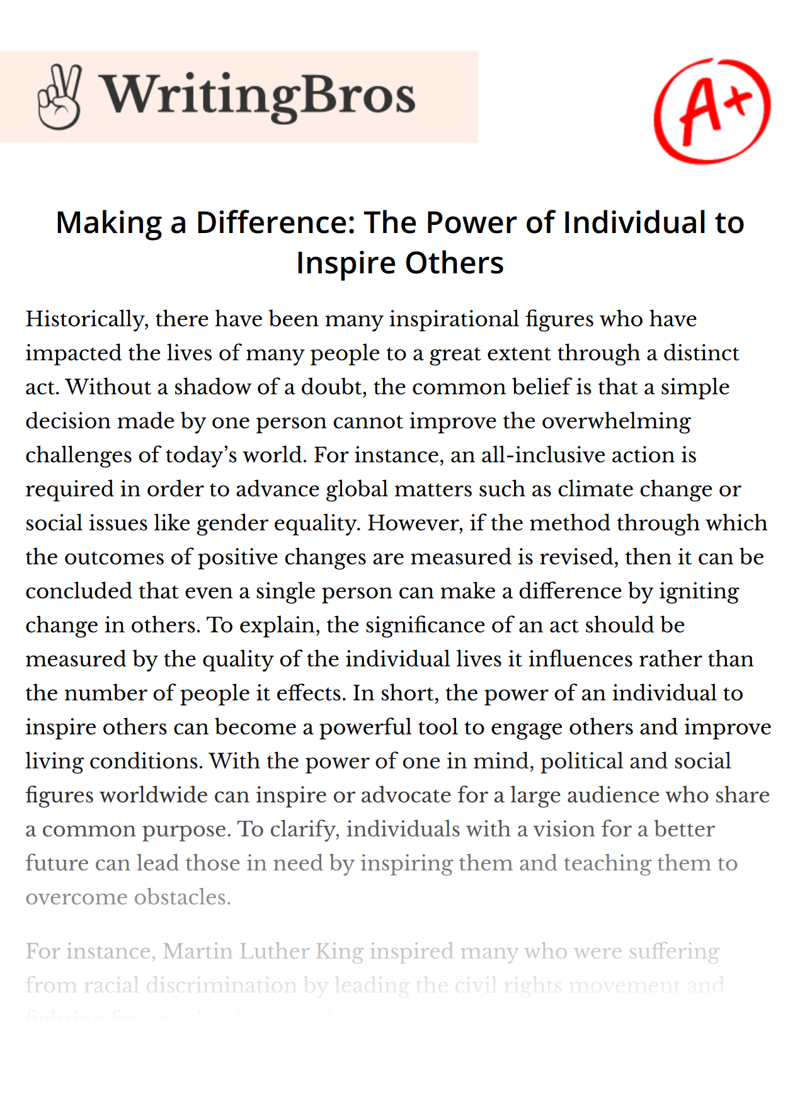Making a Difference: The Power of Individual to Inspire Others

Historically, there have been many inspirational figures who have impacted the lives of many people to a great extent through a distinct act. Without a shadow of a doubt, the common belief is that a simple decision made by one person cannot improve the overwhelming challenges of today’s world. For instance, an all-inclusive action is required in order to advance global matters such as climate change or social issues like gender equality. However, if the method through which the outcomes of positive changes are measured is revised, then it can be concluded that even a single person can make a difference by igniting change in others. To explain, the significance of an act should be measured by the quality of the individual lives it influences rather than the number of people it effects. In short, the power of an individual to inspire others can become a powerful tool to engage others and improve living conditions. With the power of one in mind, political and social figures worldwide can inspire or advocate for a large audience who share a common purpose. To clarify, individuals with a vision for a better future can lead those in need by inspiring them and teaching them to overcome obstacles.
For instance, Martin Luther King inspired many who were suffering from racial discrimination by leading the civil rights movement and fighting for equal political rights in the 1960’s. Similarly, African-American runners, Tommie Smith and John Carlos raised their fists at the 1968 Olympics while the American national anthem was playing at the awards ceremony to expose the racial inequality that had been afflicting many in the United States at the time (Lewis, 2006). Their action received major criticism worldwide since it interlaced politics with sports, but was praised by many since they had advocated for those who were stripped of their civil rights. Thus, a single act such as giving an influential speech or raising a fist can either shed light on a situation or engage and inspire many to confront challenges.
Additionally, influencing even a few people may cause a ripple effect, which can eventually impact many more through time. To elaborate, those who are truly inspired by influential figures implement changes in their own lifestyle according to their goals, and they may become an inspiration to many others. This matter is also a critical factor in parenting since routines are mainly established at a young age as children adjust to their parents’ habits. For instance, children who grow up seeing their parents recycle understand its benefits and follow in their steps. In the long term, a small act such as sorting and separating trash reduces a household’s waste and helps the environment. Hence, the value of a difference made in any situation or magnitude should not be underestimated as it may lead to a greater influence in time.
Undoubtedly, many people share the pessimistic mindset that underestimates the significance of a single person and the power of their actions. However, since this common mindset has no constructive value, the impact of any action, either positive or negative, must be emphasized to motivate individuals to ignite social change for what they believe in. It is then that even ordinary people who believe they are insignificant in the overwhelming scheme of life can ignite change through any single thought or decision by shifting towards a more optimistic ideology. As has been noted, choices that are aligned with our goals and beliefs should be made in order to benefit our future and improve communities. For instance, embracing different narratives rather than forcing minorities to integrate into the fold and adjusting our normative behaviors as a society can improve the social climate. Hence, change can be triggered when a group of like-minded individuals who have gravitated towards each other based on their passion work together to advance their agenda.Reference:Lewis, R. (2006). Caught in Time: Black Power salute, Mexico, 1968. The Sunday Times.
Cite this Essay
To export a reference to this article please select a referencing style below

